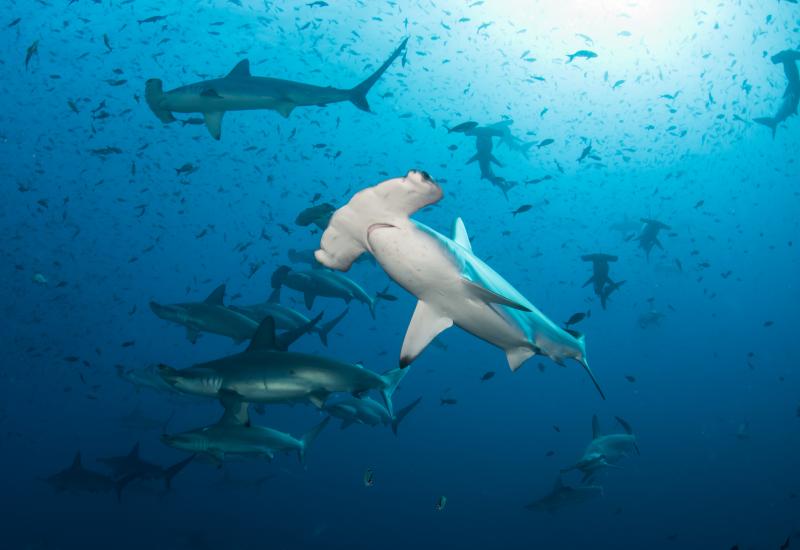Pelagic City
''Everywhere we looked, we saw hammerhead sharks'' Forty minutes. According to my computer, that was the elapsed time. Although the dive was nearing completion, it still felt as if we had just arrived. It was like setting foot in a huge party with everything already in full swing. Literally everywhere we looked, we saw sharks - scalloped hammerhead sharks. We were surrounded by an uncountable number of these impressive brutes, each measuring 8 to 10 feet in length. They were easily identified as scalloped hammerheads by their flat, T-shaped heads with the repeating crescent curves along the leading edge. Mixed in among the ranks of this ever-enigmatic species, as if only to keep the crowd from appearing too uniform, were several moderately inquisitive silky and Galapagos sharks. To say it was impressive would have been the understatement of the year. The exceedingly warm waters of El Nino were definitely gone. In their place, the re-chilling effects of ''La Nina'' had obviously reached full force, bringing water temperatures down past the normal mid-70s into the low 60s. Ah, thank goodness for the comfort of a good-fitting 6.5-mm suit. With Mother Nature finally deciding to reverse course, it could be said that the Galapagos Islands have bounced back to normality with a vengeance. Of course, normal here does not mean tame. Our dive began with a roll over the side of an inflatable, a short distance off Darwin Island, the northernmost island in the Galapagos Archipelago. Our dive plan was to find a place in the rocks, settle down and let the show begin. Descending rapidly, we reached the bottom after passing through a 60-foot maze of huge jacks, rainbow runners and, naturally, the area's ever-present scalloped hammerheads. Yes, the party was obviously in full swing. The sensation of observing the sharks here, as they cruise back and forth in the blue repeatedly climbing the steep, sloping contours of the reef, is that they don't care about the presence of divers. I have enjoyed watching these denizens glide by in the distance during my numerous trips to the Socorro Islands, Malapelo and Costa Rica. But seldom have I had the pleasure of an up-close encounter. Here, they were close P very close P repeatedly passing within 10 feet and occasionally coming within four or five feet. Without question, the place was hopping. Looking out toward the blue, and watching everything circle and pass, the impression of a large shadow began to emerge in the distance. It was close to the surface, making me think initially that it was a large boat approaching. But as it got closer, I noticed that no engine noise of any kind could be detected. A quick look at Fernando, the chief divemaster of the Aggressor I who was 20 feet away, corroborated my suspicion: whale shark! Without a second's delay, the group was off the bottom and racing toward the owner of the giant shadow. As we approached, the shape grew rapidly in size and detail, confirming my first guess. In seconds we were face to face and substantially dwarfed by a 35-foot behemoth. This is a photographer's dream, and I wasn't going to miss it. Backpedaling rapidly, I moved a few feet in front of its massive head to get the right shot. All I could think was, ''Wow, that's an awfully big animal!''Experiencing It AllSeveral hundred miles from the nearest airport and completely uninhabited on land, the only way to dive the Galapagos Islands is by liveaboard. The trip on the Galapagos Aggressor I provided nothing less than an extravaganza of encounters with marine animals of all shapes and sizes. If you can name it, we had seen it or were in the process of seeing it. In the rocky shallows of San Cristobal Island, marine iguanas grazed on algae while sea lions playfully cavorted all around us. Off North Seymour Island (to the north of Santa Cruz Island), each drift dive was like riding a giant conveyor belt as it rolled past mantas, schooling eagle rays, sea lions and green sea turtles. In between, scalloped hammerhead and Galapagos sharks appeared, disappeared and then reappeared. Although Seymour presented more varieties of large marine animals than I thought possible on a single dive, the pihce de risistance is still the region's most northern islands, Wolf and Darwin. The Galapagos reputation has rebounded twofold. La Niqa is apparently still moving in full force with record after record sightings of huge 30- to 40-foot whale sharks (peak season is July, August and September), in addition to the normal schooling hammerhead action and everything else. Looking for a wild place to dive? Try the Galapagos Islands on for size. Galapagos Live-AboardsWithout question, the way to dive Darwin's Islands is from a Galapagos live-aboard. Currently, there are four vessels with full capability for whisking you away to the region's most superb dive sites for big animal encounters. Lammer Law: _ A 93-foot, 16-passenger luxury trimaran sailing ship. _Galapagos Aggressor I and II: Each is an 85-foot, 14-passenger luxury dive cruiser. _Sky Dancer: _ A 100-foot, 16-passenger luxury dive yacht.










